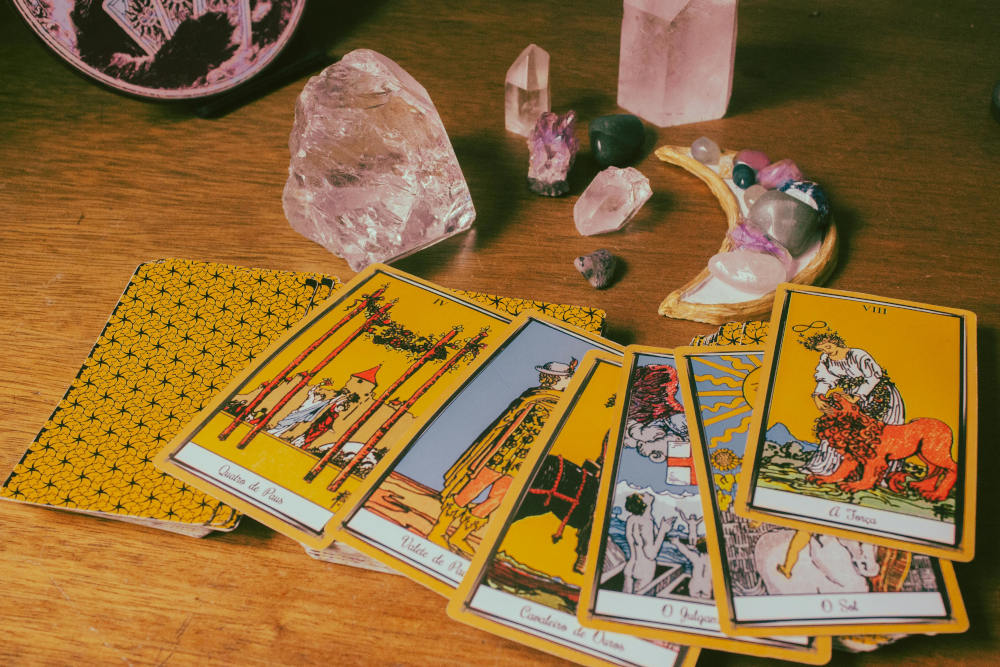
Tarot wird heute oft als Werkzeug der Wahrsagerei, der Selbstreflexion und des spirituellen Wachstums angesehen, doch seine Ursprünge und religiösen Verbindungen sind komplex und vielschichtig. Im Gegensatz zu den großen Weltreligionen mit klaren Lehren und strukturierten Strukturen ist Tarot nicht an eine einzige religiöse Tradition gebunden. Stattdessen wurde es über Jahrhunderte von einer Vielzahl spiritueller und mystischer Systeme beeinflusst, darunter Hermetik, Kabbala, Christentum und moderne New-Age-Spiritualität. Das Verständnis, wie Tarot mit verschiedenen religiösen und esoterischen Traditionen in Verbindung gebracht wurde, ermöglicht ein tieferes Verständnis seiner reichen Geschichte und seiner sich entwickelnden Bedeutung.
Die Ursprünge des Tarot: Ein Spiel, kein religiöses Werkzeug
Tarotkarten wurden erstmals im Italien des 15. Jahrhunderts erfunden, hauptsächlich für das Spiel „Tarocchi“. Frühe Kartenspiele, wie das Visconti-Sforza-Tarot, waren kunstvoll verziert und wurden vom Adel zur Unterhaltung genutzt. Es gibt keine Hinweise darauf, dass diese frühen Tarotkarten ursprünglich für mystische oder religiöse Zwecke gedacht waren. Es handelte sich lediglich um Spielkarten, ähnlich wie heutige Bridge- oder Pokerkarten, allerdings mit einem zusätzlichen Satz „Trumpfkarten“ mit allegorischen Bildern.
Erst Jahrhunderte später erlangte das Tarot eine spirituelle Bedeutung. Dieser Wandel wurde maßgeblich durch die europäische Okkultismus-Renaissance des 18. und 19. Jahrhunderts vorangetrieben, als Mystiker und Gelehrte begannen, das Tarot durch die Linse alter Weisheitstraditionen neu zu interpretieren.
Hermetik und Tarot
Eines der ersten großen religiös-philosophischen Systeme, das das Tarot beeinflusste, war die Hermetik. Sie ist eine Reihe philosophischer und religiöser Überzeugungen, die hauptsächlich auf Schriften basieren, die Hermes Trismegistos zugeschrieben werden, einer mythischen Figur, die Elemente des griechischen Gottes Hermes und des ägyptischen Gottes Thot vereint. Diese Lehren betonten die Einheit des Göttlichen, die Verbundenheit aller Dinge und die Idee, dass spirituelles Wissen durch persönliche Offenbarung erlangt werden kann.
Im späten 18. Jahrhundert behaupteten Persönlichkeiten wie Antoine Court de Gébelin, das Tarot stamme aus dem alten Ägypten und enthalte hermetisches Wissen. Obwohl diese historischen Behauptungen widerlegt wurden, bleibt die Verbindung zwischen Tarot und hermetischem Denken stark. Der Hermetismus lieferte einen spirituellen Rahmen, der das Tarot als symbolische Karte der Reise der Seele zur Erleuchtung betrachtete.
Kabbala und Tarot
Ein weiterer starker Einfluss auf die religiöse Interpretation des Tarot kommt von der Kabbala, einer Form der jüdischen Mystik. Kabbalisten glauben an eine komplexe Struktur des Universums, symbolisiert durch den Baum des Lebens, der die Wege zwischen göttlichen und irdischen Reichen darstellt.
Im 19. Jahrhundert integrierten Mitglieder des Hermetic Order of the Golden Dawn – einer einflussreichen esoterischen Gesellschaft – kabbalistische Prinzipien in ihre Tarot-Praxis. Sie verknüpften die 22 Karten der Großen Arkana mit den 22 Pfaden des Lebensbaums und ordneten die Karten hebräischen Buchstaben zu. Diese Synthese trug dazu bei, den Ruf des Tarot als tiefgründiges spirituelles Werkzeug und nicht nur als bloßes Mittel zur Wahrsagerei zu festigen.
Christliche Mystik und Tarot
Christliche Symbolik ist auch im Tarot zu finden, insbesondere in frühen Decks. Viele Karten enthalten Motive aus der christlichen Ikonographie, wie zum Beispiel die Engelsfiguren im „Gericht“ oder die päpstliche Figur im „Hierophanten“ (in älteren Decks manchmal „Der Papst“ genannt).
In der Renaissance war das Christentum die dominierende kulturelle und religiöse Kraft in Europa. Daher ist es nicht verwunderlich, dass christliche Themen Eingang in die Tarotbilder fanden. Einige moderne christliche Mystiker betrachten das Tarot als Darstellung der Reise der Seele zur Vereinigung mit Gott und sehen darin eine Erzählung von spirituellem Wachstum und Erlösung.
Viele etablierte christliche Konfessionen standen dem Tarot jedoch schon immer misstrauisch oder ablehnend gegenüber. Sie brachten es mit Okkultismus in Verbindung und warnten vor seiner Verwendung. Diese Spannung besteht bis heute fort. Einige christliche Gruppen verurteilen das Tarot, während andere es als Werkzeug für kontemplatives Gebet und spirituelle Erkundung wiederentdecken wollen.
Der Golden Dawn und die Wiederbelebung des modernen Tarot
Im späten 19. Jahrhundert spielte der Hermetic Order of the Golden Dawn eine entscheidende Rolle bei der Entwicklung des modernen Tarot. Seine Mitglieder, darunter berühmte Persönlichkeiten wie Arthur Edward Waite und Aleister Crowley, entwarfen neue Tarotdecks mit vielschichtiger Symbolik aus Hermetik, Kabbala, Astrologie und Alchemie.
Waite arbeitete mit der Künstlerin Pamela Colman Smith zusammen, um das Rider-Waite-Smith-Tarot zu entwickeln, das 1909 veröffentlicht wurde. Dieses Deck ist bis heute das am weitesten verbreitete Tarot. Seine Bilder wurden sorgfältig gestaltet, um esoterische Lehren einem breiteren Publikum zugänglich zu machen. Dies unterstreicht die Verbindung des Tarots zur mystischen Spiritualität und nicht zu einer einzelnen organisierten Religion.
New-Age-Spiritualität und zeitgenössisches Tarot
Im 20. und 21. Jahrhundert fand das Tarot eine neue Heimat in der New-Age-Spiritualität, einer breiten und vielseitigen Bewegung, die sich auf östliche und westliche Traditionen, Metaphysik, Psychologie und Philosophien der persönlichen Ermächtigung stützt.
Im New-Age-Kontext wird Tarot oft als Werkzeug für Folgendes angesehen:
-
Selbstfindung und persönliches Wachstum
-
Intuitive Entwicklung
-
Meditations- und Achtsamkeitspraktiken
-
Verbindung mit höherem Bewusstsein oder spirituellen Führern
Anstatt an eine bestimmte religiöse Doktrin gebunden zu sein, ist Tarot innerhalb der New-Age-Spiritualität flexibel, individuell und erfahrungsorientiert. Praktizierende werden ermutigt, ihre eigenen Bedeutungen in den Karten zu finden und sie als Spiegel ihrer inneren Landschaften zu nutzen.
Wicca, Heidentum und Tarot
Auch Wicca und andere moderne heidnische Religionen haben Tarot als heiliges Werkzeug angenommen. In diesen Traditionen wird Tarot oft in Ritualen, Zaubersprüchen und als Methode der göttlichen Kommunikation verwendet.
Wicca schätzt insbesondere die Zyklen der Natur, das Gleichgewicht göttlicher männlicher und weiblicher Energien und die persönliche Intuition – all dies spiegelt sich stark in den Themen und der Struktur des Tarot wider. Viele Wiccans betrachten das Tarot als lebendiges Symbolsystem, das natürliche und spirituelle Wahrheiten widerspiegelt.
Ist Tarot eine eigene Religion?
Trotz seiner tiefen spirituellen Bedeutung ist Tarot keine Religion. Es hat weder einen Gründer noch einen heiligen Text, noch ein System der Anbetung oder vorgeschriebene Glaubenssätze und Praktiken, denen alle Anhänger folgen müssen. Tarot wird vielmehr als symbolische Sprache und spirituelles Werkzeug verstanden, das an viele verschiedene religiöse und philosophische Systeme angepasst werden kann.
Für manche ist das Tarotlesen rein psychologisch – eine Methode, das Unterbewusstsein zu erreichen. Für andere ist es mystisch, ein Weg, göttliche Weisheit oder das kollektive Unbewusste anzuzapfen. Seine Vielseitigkeit hat dazu beigetragen, dass Tarot über Kulturen und Jahrhunderte hinweg so erfolgreich war.
Fazit: Ein spirituelles Mosaik
Das Tarot ist ein einzigartiges spirituelles Artefakt, das sich nicht einer Religion zuordnen lässt. Vielmehr wurde es von einer Vielzahl religiöser und mystischer Traditionen geprägt und steht auch weiterhin mit ihnen in Wechselwirkung – von der Hermetik und Kabbala über das Christentum und New-Age-Spiritualität bis hin zu Wicca und darüber hinaus.
Heute dient Tarot als Brücke zwischen dem Heiligen und dem Weltlichen und bietet Suchenden die Möglichkeit, ihre innere Welt zu erforschen, sich mit universellen Energien zu verbinden und spirituelle Erkenntnisse zu erlangen – und das alles, ohne sich an einen bestimmten religiösen Rahmen halten zu müssen. Seine anhaltende Anziehungskraft liegt in seiner Offenheit, seiner reichen Symbolik und seiner Fähigkeit, Menschen überall auf ihrer spirituellen Reise zu begegnen.
War dieser Artikel hilfreich für Sie? Bitte teilen Sie uns in den Kommentaren unten mit, was Ihnen gefallen oder nicht gefallen hat.
About the Author: Alex Assoune
Wogegen Wir Kämpfen
Weltweit-Konzerne produzieren in den ärmsten Ländern im Übermaß billige Produkte.
Fabriken mit Sweatshop-ähnlichen Bedingungen, die die Arbeiter unterbezahlt.
Medienkonglomerate, die unethische, nicht nachhaltige Produkte bewerben.
Schlechte Akteure fördern durch unbewusstes Verhalten den übermäßigen Konsum.
- - - -
Zum Glück haben wir unsere Unterstützer, darunter auch Sie.
Panaprium wird von Lesern wie Ihnen finanziert, die sich unserer Mission anschließen möchten, die Welt völlig umweltfreundlich zu gestalten.
Wenn Sie können, unterstützen Sie uns bitte monatlich. Die Einrichtung dauert weniger als eine Minute und Sie werden jeden Monat einen großen Beitrag leisten. Danke schön.































0 Kommentare